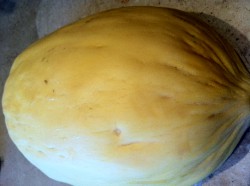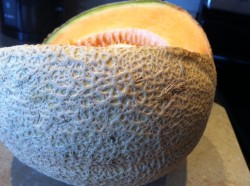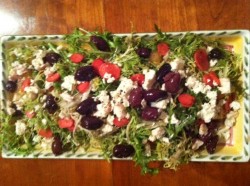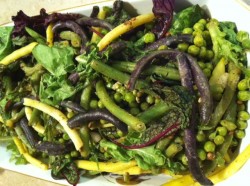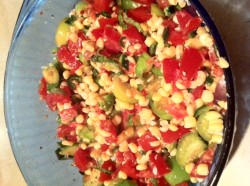Sat 8/27/11 Farmshare CSA Newsletter
Pick up your share boxes just in time before Hurricane Irene hits! You should be all set for the week with your week’s worth of fresh and seasonal produce, but do make sure you have extra tinned goods and non-perishables, your flashlights charged, some extra candles and matches just in case, freeze water in plastic bags before (and if) the electricity goes out, maybe even some blue tape for around the windows…stay inside, away from the windows, safe, and dry!
What’s In This Week’s Box:
Vegetables:
Red Romaine Lettuce
Tomatoes
Cherry Sungold Tomatoes
Baby Cabbage
Swiss Chard
Carrots
Tri-Color Bean Mix
Bi-Color Corn
Fruit:
Yellow & White Peaches
Nectarines
Melon
Mixed Apples
Raspberries
Storage & Handling Tips
Melons
A melon in general should be heavy for it’s size and without bruises. The undertones of the melon should be more yellow than green. Cantaloupe are considered to be netted melons as their surface skin is covered in a web of netted veins. The veins should be pronounced and golden, not green. The inside cavity also contains seeds that are enclosed in a netted web. Knocking on the melon is one way of seeing if it is ripe enough to eat – the cavity inside should sound hollow whereas a honeydew’s seeds will rattle inside when ripe. Like most fruit, trust your nose and smell the fruit, the aroma should be incredibly fragrant. Watermelons are part of the melon family that have smooth skins. They should have a deep, rich skin color and a waxy surface. “Sugar spots” are a good indicator of a good smooth-skinned melon; they are brown flecks that supermarkets usually wash off as imperfections. Crenshaw melons, long and oval in shape, are the most aromatic when ripe and should have a bright yellow skin covering a golden pink flesh. Honeydew should have a smooth, pale yellow-green surface. The blossom end should be rather soft with a slight fragrant aroma. French melons are small and have a grayish yellow-green skin. With its flowery aroma, it is easy to tell when it is ripe as it look as though it is about to burst open.
Storage: An whole, unripe melon should be left at room temperature. Cut melon should not be left out at room temperature for more than 2 or at most 4 hours and for a chilled melon, refrigerate it only overnight. After being picked, a melon will continue to soften, but it will not get any sweeter. Do not put melon in the fridge with strong smelling foods as they will easily absorb those other flavors.
Medical: Watermelon and cantaloupe have a low calorie count (one cup of cantaloupe = 56 calories, watermelon 48 calories). With its orange flesh, cantaloupe is very high in beta-carotene, which is good for your eye sight, so it is very high in Vitamin A, which is good for lung health. It also contains a high amount of Vitamin C which not only acts as an antioxidant, but it protects the immune system by encouraging white blood cells to fight against infections, kill bacteria and viruses, and rejuvenates inactive Vitamin E within the body. Cantaloupe is also high in potassium and dietary fiber. The B Vitamins cantaloupe contains help process carbohydrates and along with the amount of fiber, regulates the flow of sugar into the bloodstream. Watermelon is filled with lycophene which is very strongly preventive of cancer.
Fact: Melons are related to squash, pumpkins, and plants that grow off vines on the ground. What we call cantaloupe in America is actually a muskmelon. The true variety of cantaloupe is found mostly in France. Cantaloupe were first cultivated in 1700 A.D. in Italy in a town called Cantalup, where its name derives from.
Cooking
Salad Tips:
*Season each of the ingredients of the salad individually.
*Drizzle olive oil or vinaigrette around the salad bowl sides then toss with the lettuce rather than directly on top to make sure that all leaves are coated evenly.
*Add herbs last and leave herbs whole, except for chives, so that the flavor is not left on the cutting board.
*Fresh, delicate greens really just need some salt and quality extra virgin olive oil.
*If making a salad with a lot of ingredients, use a shallow platter to distribute them evenly and think about the size/weight of the ingredients so that the more delicate ones are on top.
It would be really easy to make a salad with the romaine, cherry tomatoes, chopped carrots, and corn kernels but what about adding thin slices of jersey mac apples with some walnuts and crumbled blue cheese to your romaine?
Have you ever panfried romaine lettuce?
Heat a large pan over moderate heat with a tablespoon of olive oil and place a halved romaine cut side down and sprinkle with 1/4 teaspoon of sea salt. Cook for about 2 minutes until browned, then flip with tongs and cook until crisp, about another 2 minutes. Cool and serve at room temperature.
Melon Salad
About 5 lbs assorted melons, room temperature, cut into any free-form desired shape, slice, cube or ball.
1 head frisee, washed and dried
12 small French breakfast radishes, trimmed and thinly sliced
1/4 cup extra virgin olive oil
2 tablespoons balsamic vinegar
salt
3 oz feta cheese, drained, cut into 1/2 inch cubes
1/4 cup pitted Kalamata olives, quartered lengthwise
small mint leaves (optional)
Pour the oil and vinegar in a bowl and swirl to make a vinaigrette. Toss the frisee and radishes in a medium bowl and drizzle about half of the vinaigrette around the sides of the bowl. Toss to coat and season to taste. Arrange some of the melon on a serving platter, drizzle with some vinaigrette and repeat with more melon and vinaigrette, layering as you build the salad. Loosely place the lettuce on top of the melon then scatter with feta cheese and olives. Garnish with mint leaves.
* Adapted from Thomas Kellar’s Ad Hoc at Home. The sweet melon goes fabulously with the salty of the cheese and olives and the slight bitterness of the frisee. I made this salad with only a Crenshaw melon and it was delicious, although a variety of melons would add more color, an array of texture and a medley of flavor. He also included toasted pine nuts and 1 English cucumber which I did not have. I used some pickled radishes I had made rather than small wedges like his recipe called for (boil 2 parts vinegar to 1 part sugar, 1 part water and let cool, add radishes – or any veg – into a canning jar and pour the room-temp pickling liquid over them, let stand for 30 minutes, cover, refrigerate up to 1 month)
Watermelon, cut into cubes, goes fantastically with some feta cheese, red onion, pine nuts, and fresh basil. Drizzle with some good extra virgin olive oil, a sprinkle of sea salt and a generous amount of freshly ground black pepper.
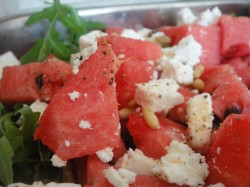 The juicy sweetness of melon pairs incredibly well with salty foods – like feta – so wrapped slices of melon with prosciutto is delicious and easy.
The juicy sweetness of melon pairs incredibly well with salty foods – like feta – so wrapped slices of melon with prosciutto is delicious and easy.
Chickpea Saute with Swiss Chard, Carrots and Greek Yogurt
3/4 lb Swiss chard
1/3 cup olive oil plus 1 tablespoon
4 medium carrots, peeled and cut into 3/8-inch dice
1 tsp Carranza seeds
1 1/2 cups chickpeas (canned or fresh)
1 garlic clove, crushed
1 tablespoon chopped mint
1 tablespoon chopped cilantro
1 tablespoon lemon juice
salt and pepper
1/2 cup Greek Yogurt
In a pot of boiling salted water, blanch the Swiss chard stalks for 3 minutes then add the leaves. Drain, rinse under cold water, squeeze dry then chop roughly.
Heat the olive oil over medium heat and cook the carrots and caraway seeds for about 5 minutes. Add the chard and Swiss chard. After about 6 minutes, add the garlic, herbs, lemon juice and season with salt and pepper. Remove from the heat.
Mix the yogurt with 1 tablespoon of olive oil with salt and pepper. To serve, put the vegetables on a plate and dollop the yogurt on top. Add more salt and pepper to taste and drizzle with olive oil.
Tri-Color Bean Salad
1 1/2 lb beans (1 share bag)
2 cups green peas (fresh or frozen)
2 tsp coriander seeds, roughly crushed
1 tsp mustard seeds
3 tbsp olive oil
1/2 small red onion, finely chopped
1 mild chile, seeded and finely chopped
1 garlic clove, crushed
zest of 1 lemon
2 tbsp chopped tarragon
1 cup chard leaves
Sherry or red wine vinegar
Blanch the yellow and green beans in a pot of salted boiling water for 4 minutes then immediately drain in a colander under cold water. Wash the purple beans and add them to the beans. In another pot of boiling water, blanch the peas for about 20 seconds then drain and dry and combine with the beans.
Put the coriander and mustard seeds with the oil in a small pan over moderate heat. Once they begin to pop, pour over the beans and peas. Toss together and add the red onion, chile, garlic, lemon zest and tarragon. Mix well and season. Fold in the chard leaves or salad mix and sprinkle with the vinegar. Would be delicious also with some pesto.
Corn Salsa
I made corn salsa the other night to bring to a picnic to watch a live band play in Prescott park. It’s extremely versatile, given what’s in your box and depending on your personal preference. I used two ears of corn – shucked the kernels into a large bowl, roughly cut up 3 tomatoes with their juices (halved sungold tomatoes would add a lot of vibrant color and sweetness), cut up one white onion into small dices, one green chile (plus extra dried chile flakes – I like HOT salsa!), I had a couple tomatillos which added a bit of sweetness. Feel free to add whatever you have, whatever you like, add some peaches! Add shrimp and grilled watermelon! Chop up some fresh basil and/or cilantro and season with salt and pepper. With the leftovers the next day without any more chips, I added some freshly washed lettuce and made it into a salad with a drizzle of extra virgin olive oil.
So easy. Such summery goodness.
and sideways…
Sources and Inspiration by Russ Parsons; Fruit, Herb & Vegetable Encyclopedia; Ottam; Thomas Keller, Applecrest.
Enjoy! S.E.R.

